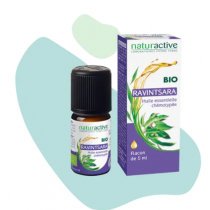Indications
Treats benign respiratory infections, colds, bronchial blockage (anti-septic & mucous-flow EO).
For dermal application: treats benign viral skin infections (cold sores)
Botany information
Cinnamomum camphora ct 1,8-cinéole
Botanical family: Lauraceae
Producing organ: leaves
Chemotype: 1.8 cineole, sabinene, alpha-terpoineol, alpha and beta-pinene.
Origin: Madagascar
Botany specifications
Madagascar has numerous medicinal species. The Ravintsara distinguishes itself by its size and dense foliage covered in red berries. Its name originates from the Madagascan Ravina; leaf and tsara; good. The Ravintsara is often confused with another tree with the name Revensare, these are two completely different species.
Use
Diffusion +++, Bath +, Massage ++, Orally +
Ambient setting: on its own or in a mixture by regular low heat evaporation.
Atmospheric diffusion: in a mixture from a diffuser by spraying.
Dermal application: diluting, 5-15% (maximum 30%) in vegetable oil.
Orally: diluted with some vegetable oil - only after medical agreement. 1-2 drops 3 times per day.
Dry inhalation: 1-2 drops on a tissue.
Wet inhalation: 2 drops in bowl of boiling water.
Practical advice
Winter illnesses : 135 drops of ravintsara EO in a 30ml bottle with the rest filled with macadamia vegetable oil. Apply onto the chest 4-6 times per day.
Combats the flu : Dilute 100 drops of ravintsara EO + 35 drops of tea-tree EO in a 30ml bottle. Apply once per day (on the chest, wrists, elbow crease or sole of the feet). In the case of an influenza attack: 4-6 times per day.
Calming effect : A powerful anti-viral, the ravintsara essential oil does not contains camphor. Diffusing this oil purifies the home and gives off a pleasant balsamic fragrance.
To breathe easier during the night : 15 minutes before going to bed, diffuse ravintsara EO with or without mandarin or Tea-Tree EO into the bedroom.
Contraindication
Contains eucalyptol. Not recommended for pregnant or breast feeding women or children under 6 years of age.




